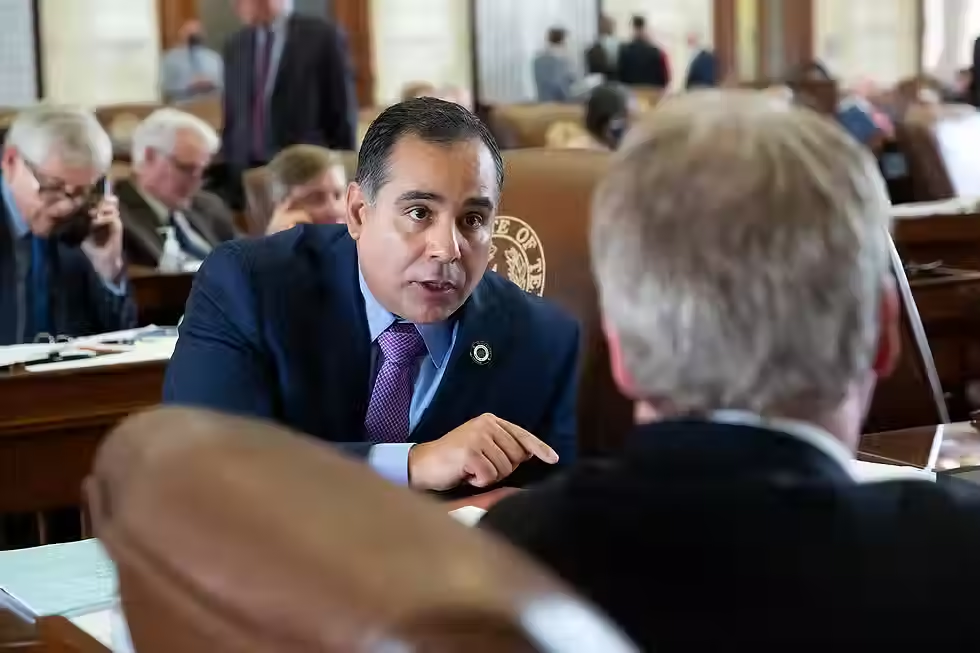Devils River Wins “First-of-its-Kind” Pollution Protections through the Passion of Grassroots Advocates: A Conversation
- Eddie Martinez

- Aug 5
- 6 min read
A Q&A with Romey Swanson, Executive Director of the Devils River Conservancy
The Devils River — just an hour north of Del Rio and widely regarded as Texas’ most pristine waterway — has won landmark protections under Texas House Bill 3333, a new law that shields it from wastewater pollution starting this September. Authored by Val Verde County’s State Rep. Eddie Morales and backed by multiple Texas Senators, the true force behind the bill is the Devils River Conservancy (DRC), the grassroots conservation group that inspired the legislation giving a voice to the landscape, empowering landowners, and pleasing land-lovers alike.
Romey Swanson, Executive Director of the DRC, spoke with DRN about how this law will safeguard the wild Devils River, and the months-long advocacy effort that made it happen — indeed a conversation about conservation.
You can dive into Romey's remarks below, but the heart of the story is this:
The DRC foresaw a future where the river’s purity could be compromised by wastewater runoff from private land operations along the Devils River.
Choosing radical intervention, the self-proclaimed “Devil’s advocates” launched a campaign to enact legislation that halts further pollution and promotes a shared ethic of stewardship among the region’s landowners.
In the end, the DRC turned grassroots advocacy into legislative action, resulting in a first-of-its-kind state law preserving the health of the Devils River — a victory that both protects Val Verde County’s natural treasure and formally recognizes it as a resource to be conserved by the State of Texas.
Note: Responses have been edited for concision.
DRN: Thanks so much for your time today. First thing, how do you feel about this big win?
Swanson: Speaking on behalf of the Devils River Conservancy, we couldn’t be happier with the outcome. There are a number of reasons why we are happy, but the primary one is that we pursued a policy tool that was appropriate for our landowners and landscape.. […]
This is a first-of-its-kind acknowledgment that the Devils River in Texas is one of the most special rivers; one of the most special conservation assets in the State of Texas. And it recognizes that the stewardship of our private landowners is largely the reason we have this opportunity and good policies will complement good landowner stewardship.
So yes, a very long answer to a short question: yes we are very, very happy. And so too are our partners, our friends throughout the landscape, our constituents within the basin, the City of Del Rio, the commissioners court of Val Verde County. We’re all very happy with the outcome.


DRN: Can you tell me a little bit about the work the DRC does both as conservationists and advocates?
Swanson: Absolutely. So many organizations galvanize around problems, and that certainly was the origins of the Devil's River Conservancy — to speak on behalf of the Devil's River while decisions are being made that affect and impact it.
Whether it’s the rock art, dark skies, or the wildlife. We work on behalf of that and this river.
The mission of the DRC is to “Treasure - Preserve - Protect” the Devils River and the landscapes around it, and we take that mission very seriously. It’s really easy to Treasure the River. You take one look and oftentimes you fall immediately in love. But it’s a lot harder to Preserve and Protect the River. Fortunately we have great partners both with our State agencies and the landowners in the private sector.
The way that we advocate for the River is we make sure it has a voice, and that when decisions that impact it are being made; that if we aren’t leading those, we are significantly contributing our voice to those decisions.
DRN: What are the key protections that this legislation (Texas House Bill 3333) grants?
Swanson: This legislation was about assuring a very high water quality for the Devils River. The Devils River is known across the state of Texas as the most pristine stream in the state.
Again, working with our landowners to make sure that as we propped up some policy to provide water quality protections that it doesn’t negatively impact the way they do their work and their stewardship work.
What HB 3333 actually does is it prevents the TCEQ [Texas Commission on Environmental Quality] from approving permits to discharge of treated effluent wastewater. This is basically the water that comes from a pipe from a treatment plant. It is water that can contain elevated levels of phosphorus and the byproducts of pharmaceutical products. They also can’t control the temperature [of the wastewater] very well when it enters back into the [River] water. So if it’s a significant amount of water going into a River as pristine as ours, it can have negative impacts, so we felt it should be left off-limits.
Thinking of the future, this bill also sends a message to landowners, developers and speculators that says, “As you treat your wastewater products, please do it in a way that’s consistent with preserving the integrity of the River.”
So that’s what this is really about: to send a signal to those that may come out here with ideas about how to develop portions of the River, and that if they do that, they need to do with the existing culture of care and stewardship.

DRN: What are some effects of wastewater pollution for an ecological system like the Devils River?
Swanson: Well, we have several imperiled species associated with the Devils River, and some found nowhere else in the world. A lot of these imperiled species have a relationship with cooler water temperature and high water quality and can be negatively impacted by the degradation of water quality.
We’re also facing a reality of a drying climate in our region. We’re seeing longer and more pronounced drought periods, meaning that the River itself is seeing less volume pushed through. So any external influence coming into the water, whether it’s pollution or warmer water, will have a bigger impact because there’s less water to dilute those impacts.
So with the drying reality that we've experienced, the decrease in the flow of the river and the flow of the springs, we need to be much more sensitive to the impacts of some of these [wastewater] inputs.
DRN: Glimpses of a relationship between the DRC and Representative Morales can be seen on social media in early 2025. Did your advocacy directly inspire this House bill?
Swanson: Yes! So Representative Morales has been an incredible partner, and I cannot speak highly enough about him and his staff championing this bill. The bill’s origins are 100% the result of working with Rep. Morales’ office as early as November of last year.
So the timeline was, we got this bill working in December of 2024, Morales filed the bill in February 2025. Up to that point conversations had been primarily with Morales’ staff. Then we needed to move it through the House, the House Committee of Environmental Regulations, and we got it through that committee, and we got it passed in the House with majority vote. So we had a great team and Morales’ office really quarterbacked all of those points of contact within the legislature.
Then we did our work to make sure they heard from the constituents in [our] grassroots advocacy work during the House phase. Then we did more direct work with Chairman Perry, Sen Blanco, and really the entirety of the Senate Committee on Water, Ag, and Rural Affairs.
[Smiling] So a lot, a lot of work went into this.

DRN: Speaking of all this work, all this movement and energy to make this all happen — on a personal level — why do this work at all?
Swanson: It’s funny, I’ve had this conversation a couple of times today. I’ll tell you a very personal story.
This river and this landscape, in my belief and estimation, is a place where we can demonstrate a model of success in Texas — a private land state where we are very business and economic-growth-friendly and we have immense natural resources — but where we are seeing immense impacts to those natural resources as a result of our growth and developments.
What we want to do is assure a future where this river, and the people that care about it, can come see it in a state that is still pristine while championing a Texas-appropriate model of conservation and stewardship that is the crown-jewel relative to the rest of the state.
Can we preserve a landscape without needing a national park? That’s kind of the idea. We can do it and maintain a private lands model and still have something that looks pristine in its integrity held together.
And that's why I personally am convicted into doing this work and enthusiastic and passionate about it.
DRN: Love it. Well, is there anything I’m not asking that you’d like to mention?
Swanson: I'll say this. This work does not get accomplished only by the DRC, exclusively by the DRC, or me. I can't thank our community members and our partners enough for coming together in support of this bill, of seeing the wisdom in advocating for it.
I'm so proud of our many Del Rio based community partners involved with this, and I give a big nod to the Southwest Water Coalition as being sort of a small, up-and-coming group that finds a lot of alignment around these water issues. And our elected leaders, the Val Verde County Commissioners Court. They voted to support this through a resolution, which was a very powerful instrument in pursuit of this policy outcome.
We are now a shining example for the entirety of the state of what success looks like and strategies that can be mirrored in other basins.










.png)










Comments